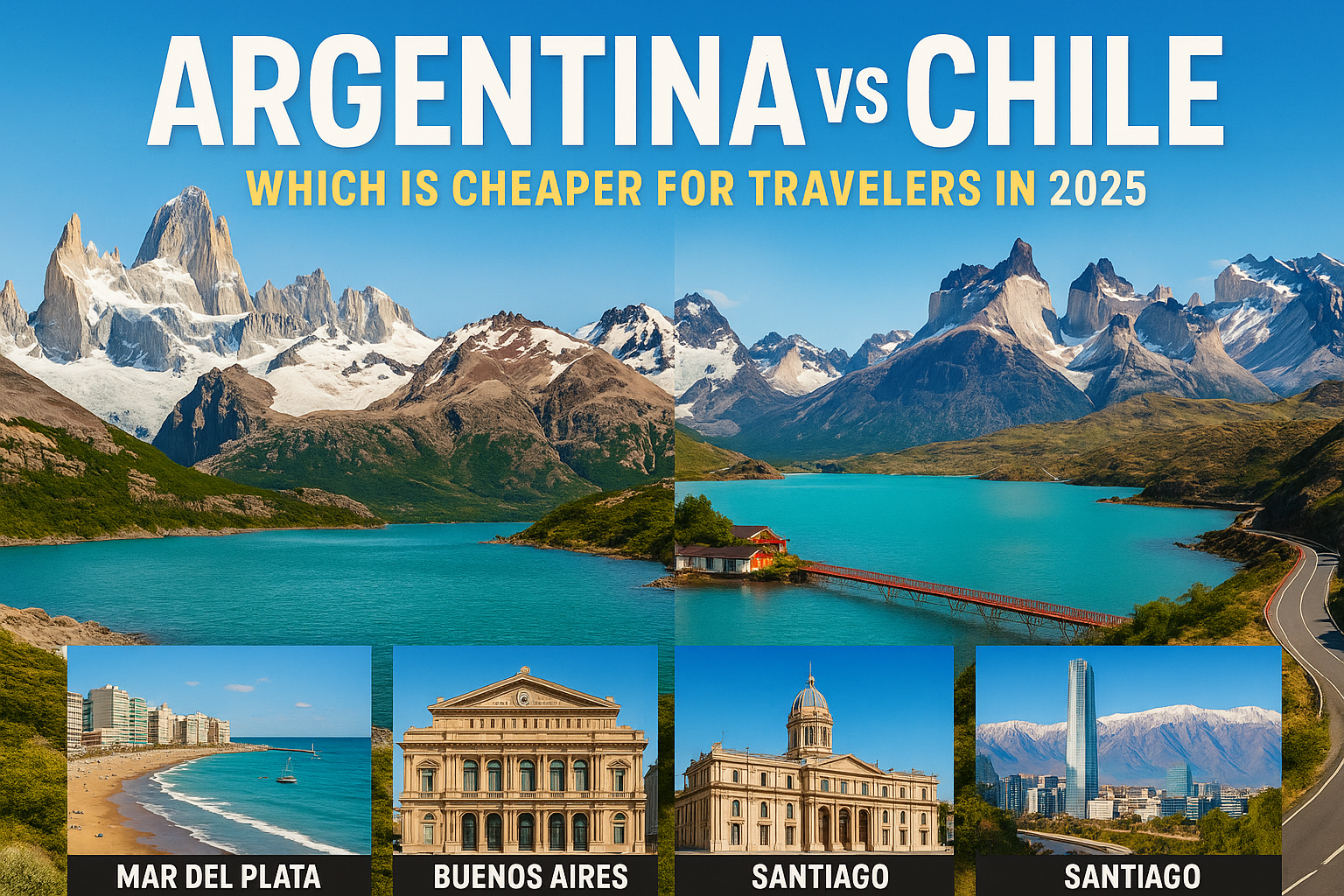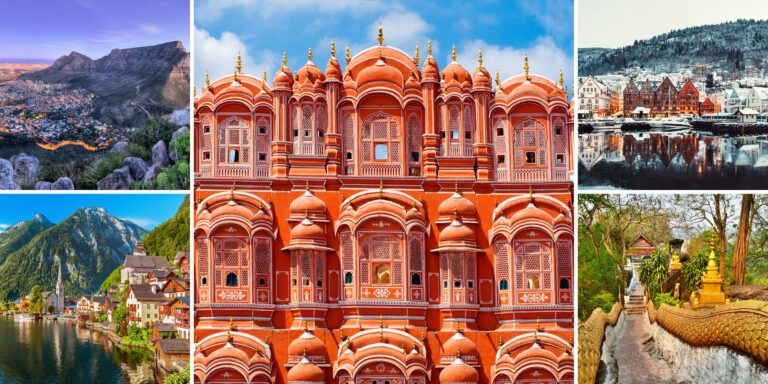Argentina and Chile are neighboring South American countries bursting with natural beauty and culture. But for a family planning a 2025 trip, one key question stands out: which country is more budget-friendly? Understanding costs in Argentina vs Chile like accommodations, food, transport, and activities can help families make a wise choice. In general, Argentina tends to be a bit cheaper than Chile for tourists.
Still, both countries offer options from budget to luxury, and costs can vary widely by season and location. Below we break down the key expense categories—accommodation, meals, transport, and more—to compare what a family of four might expect to pay in each country.

Travel Cost Overview: Argentina vs Chile
First, it helps to look at broad estimates of travel budgets in each country. According to travel experts, a one-week trip for two people (including hotels, meals, and local travel) averages about $1,028 USD in Argentina versus $1,659 USD in Chile.
Put simply, families visiting Argentina might spend roughly 30–40% less on a similar itinerary. Budget-focused travelers confirm this gap: midrange daily budgets per person run around $77 in Argentina and $118 in Chile. Even budget backpackers can see a difference: $33 per day in Argentina versus about $44 per day in Chile.
Several factors drive this price gap. Argentina’s currency (the Argentine peso) has been weak and volatile, making local prices lower for foreign visitors. Chile’s economy is more stable and costs of living are higher by South American standards.
For example, everyday expenses like groceries, restaurants, and domestic transport often cost more in Chile. That said, Chile’s modern infrastructure and distance between attractions (a long thin country with the Andes) can raise travel costs in certain regions.
In summary, Argentina usually offers better deals for family travelers, especially on lodging and food. But budget-wise differences are nuanced. Here’s a category-by-category breakdown for families on the move:
Accommodation: Hotels and Lodging
- Argentina: You’ll find many affordable hotels, hostels, and guesthouses. Budget double rooms (one bedroom for two) can start around $40–$50 per night for basic places. A decent mid-range double room often costs around $90–$100 per night. For example, travel data show the average price of a typical double hotel room in Argentina is $97. Hostels with family rooms or Airbnb rentals can be even cheaper per person (often as low as $10–$20 each). In cities like Buenos Aires, Cordoba, or Salta, competition keeps prices down.
- Chile: Hotels tend to be pricier. A budget double room starts around $60 per night, and a midrange double room averages about $118 per night. In Santiago or Valparaíso, you might pay $100–$150 for a mid-range hotel. Remote areas like Torres del Paine or Patagonia often charge premium rates (sometimes $150–$200+ for a decent room). Family-friendly lodges and inns exist, but expect to pay more than in Argentina.
Overall, a mid-range hotel for two in Chile typically costs about 20–30% more than in Argentina. For instance, data show Chile’s midrange single-person accommodation at $59 vs Argentina’s $48. Of course, splitting a double room among parents and kids can reduce per-person cost.
Still, for a family of four, booking two double rooms or a family suite will cost hundreds of dollars more in Chile on a week-long trip compared to Argentina.
Where to Stay on a Family Budget
- In Argentina: Look for apartments or B&Bs with kitchenettes to cook some meals. Neighborhoods like Palermo (Buenos Aires) or Bariloche’s city center often have good value options. Hostels with family rooms are also common.
- In Chile: Consider guesthouses or hostels in central neighborhoods. While cities may have deals, remote destinations like Atacama desert and Patagonia often book early. Planning months ahead can secure better prices.
Food and Dining Costs
Food is a category where Argentina shines for budget travelers. Fresh produce, beef, and dining out are generally cheaper in Argentina than in Chile.
- Argentina: You can eat well on a modest budget. A mid-range three-course meal for a family of four (kids sharing or ordering child’s menus) might run around $30–$40 total. Street food and casual eats are very affordable: for example, a McMeal combo is about $6, and empanadas or street sandwiches often cost under $3 each. Grocery prices are low; a gallon of milk is under $4. BudgetYourTrip data shows midrange daily food expenses as just $6.54 per person (reflecting cheap local eateries), and budget meals even less. Families can save by picnicking with local fruits (bananas <$1/lb) and empanadas. A bakery loaf is only ~$1.30.
- Chile: Eating out is more expensive. A similar three-course meal for two is about CLP 40,000 ($42), so four people might be $80+. Even simple meals cost more: an inexpensive restaurant meal is around CLP 8,000 ($8), and fast-food combos $7. Groceries run higher too; milk is about CLP 1,124/L ($1.30) and local cheese ~$10/lb. BudgetYourTrip notes midrange food spending at $38 per person per day—nearly six times Argentina’s rate. Families often dine out in restaurants, but even casual places will add up quickly.
Example Food Costs: A family of four grabbing dinner at a mid-range pizzeria might pay AR$15,000 ($30) in Argentina, versus ~$60 in Chile. Likewise, buying snacks or meals from street vendors is around half price in Argentina.
Tips on Dining Cheap
- Argentina: Enjoy local staples like empanadas, choripán (sausage sandwiches), and “menu del día” lunch specials. Supermarkets and local markets offer great produce prices.
- Chile: Look for “almuerzo ejecutivo” deals at lunchtime (set menus with protein, rice, salad) to save. Snack on market fruits or store-bought snacks. Avoid touristy restaurants and drink tap water (safe in Chile).
Transportation: Getting Around
Travel costs in Argentina vs Chile can differ sharply depending on mode of transport:
- Domestic Flights & Buses: Both countries are large, so domestic travel adds up. Internal flights are often expensive, especially in Chile’s long, narrow geography. For example, a round-trip flight from Santiago to Punta Arenas (Patagonia) can be $300+. Argentina is also big, but several cities have small domestic carriers or seasonal deals. Family road-trips by rental car are popular in both countries, but keep fuel and tolls in mind.
- Local Transport (City):
- Argentina: Public buses (colectivos) and Buenos Aires subway cost about ARS 40–50 (≈$0.30) per ride. Taxis are cheap by U.S. standards (start ~$1), but Uber is not legal. Sharing taxi rides can still be economical.
- Chile: Bus rides in Santiago or Valparaíso run ~CLP 800 ($0.90) per trip. Taxis in Santiago are pricier (start ~$1.50), but Uber and apps are available. In tourist towns, you may rely on taxis or shuttles, which add up.
- Car Rental: Renting a car can be a good option for families but is more costly in Chile. Daily rates for a compact car are roughly $30–$40 in Argentina vs $40–$50 in Chile (off-season rates). Gasoline is similarly priced (around $1–$1.20 per liter), but car insurance and one-way fees can differ. For example, dropping a rental in a different Chilean city can be extra pricey due to distances.
- Taxis and Rideshares: Short rides in Argentina are a bargain (often a few dollars). In Chile, a 5-mile taxi ride can be ~$10 or more in urban centers.
BudgetYourTrip notes local transportation costs about $3.28 per person per day in Argentina vs $14 in Chile for mid-range travelers—reflecting higher bus and taxi usage in Chile. Families can reduce costs by using public buses/trains where available and grouping travel.
Practical Transport Tips
- Argentina: Use long-distance buses (colectivos) for big-city travel—they’re comfortable and cheap (~$20–$40 USD for overnight rides covering hundreds of miles). They often include reclining seats and meals.
- Chile: Consider buses or trains (e.g. Santiago–Valparaíso bus ~$10, night buses ~$20 for long routes). Flights can save time but cost more. Book buses/ferry (to Chiloé Island, e.g.) in advance for deals.
Activities and Attractions
Both countries offer stunning parks and family activities, but entry fees and tour prices differ:
- National Parks: In Argentina, many parks charge modest fees (e.g. Iguazú Falls ~ ARS 1,800, about $4 per adult) and children often free or discounted. In Chile, parks can be pricier (Torres del Paine entrance ~$35 per adult). Tour guides and excursions (glacier treks, boat tours) also cost more in Chile’s remote areas due to difficulty of access.
- Museums and Family Activities: Museums, zoos, and aquariums in Argentine cities are generally cheap (often $1–$5 entry). Chilean cultural activities, especially in Santiago, might run $5–$10 per person. Many parks and natural attractions in both countries have minimal fees.
- Entertainment: Argentina’s vibrant street culture (free tango shows in parks, open-air art) keeps many family activities low-cost. Chilean festivals and cultural events can be more planned but some parks like Atacama or Puerto Varas have entrance fees or require guided tours (adding $20–$50 per person).
On average, expect to pay 25–50% more for guided tours and attractions in Chile. For example, a Patagonia boat cruise might be $60 per person in Argentina (with large tour operators) versus $100+ in Chile (with smaller boats).
Sample Family Budget: A 7-Day Itinerary
To illustrate costs, here’s a rough example for a family of four (2 adults, 2 children) on a week-long trip:
- Argentina Sample (7 days):
- Flights to Buenos Aires (round-trip for 4): ~$2,000 (prices vary by origin)
- Accommodation (1 week, 2 double rooms at $90/night): ~$1,260
- Food ($50/day*7): ~$350
- Local transport (subway/taxis): ~$100
- Excursions (Iguazú or Patagonia day tours): ~$200
- Misc (souvenirs, extras): ~$100
- Total: ~$4,010 for the week.
- Chile Sample (7 days):
- Flights to Santiago (round-trip for 4): ~$2,400 (Chile usually more expensive)
- Accommodation (1 week, 2 double rooms at $120/night): ~$1,680
- Food ($70/day*7): ~$490
- Local transport (buses/taxis): ~$200
- Excursions (Valparaíso tour, Atacama day trip): ~$300
- Misc: ~$150
- Total: ~$5,220 for the week.
These estimates (illustrative only) suggest Argentina might save a family ~$1,000–$1,500 on a one-week trip. Indeed, as budget experts note, “the difference in budget might not be huge, but Argentina is a little cheaper than Chile”. For families, kids often get free or discounted entries and meals, which helps lower per-person costs further in both countries.

Money-Saving Tips for Families
- Travel Off-Season: Visit in shoulder seasons (spring or fall) to avoid crowds and snag lower hotel rates and airfare. Both countries have big summer (Jan-Feb) and winter (July) peaks.
- Book in Advance: Reserve family rooms and tours early for the best rates. Last-minute booking often means premium prices, especially in Chile’s hotspots.
- Use Sim Cards/Apps: Data plans are cheap. Use apps like Google Maps or local bus apps to avoid taxis. In Argentina, the SUBE card gives cheap bus/subway fares. In Chile, get a BIP card for buses in Santiago.
- Mix Dining Options: Balance eating out with picnics or supermarket meals. Even hotel rooms with a fridge or kitchenette let families save on breakfast or snacks.
- Child Discounts: Always ask for children’s tickets or family deals (many museums and tours have them). For example, Argentine parks often let under-12’s in free or half-price.
- Currency Exchange: Argentina’s economy encourages using local ATMs over exchanging dollars (black market rate is often in your favor), but be careful of high bank fees. In Chile, use ATMs at banks for best rates (avoid currency exchange kiosks with steep fees).
- Connectivity: Wi-Fi is widely available in hotels and cafes. Buy a local SIM or eSIM with data to avoid roaming charges.
FAQs
- Q: Is food in Argentina really that much cheaper than Chile?
A: Yes. In Buenos Aires, a casual meal might cost only a few dollars per person, whereas similar meals in Santiago tend to be roughly 30–50% more expensive. Markets and street food keep daily costs especially low in Argentina. - Q: What about transportation costs?
A: Public transit is cheap in both countries, but Chile’s fares are higher. A bus ride that costs ~$0.30 in Buenos Aires might be ~$1 in Santiago. Long-distance bus travel (between cities) is affordable in both, but remember that Chile’s destinations are further apart, so more travel time or flights may be needed. - Q: How do kids factor into budgets?
A: Children often reduce per-person costs. Hotels may charge a small extra fee for kids sharing a room. Many tours allow kids under 12 free or at discount. Restaurants sometimes offer smaller kids’ meal portions (e.g. half-price). So a family of four usually pays less than double a couple’s costs. - Q: Are there areas where Chile is cheaper?
A: Certain goods, like electronics or imported items, might be slightly cheaper in Chile due to lower import taxes. Also, Chile’s modern supermarkets may have better-priced local produce during harvest seasons. But overall, daily travel expenses (food, lodging, transport) are generally lower in Argentina. - Q: How to handle currency?
A: In Argentina, cash (Argentine pesos) is king; many places don’t accept dollars or cards easily. Use ATMs or currency exchange at banks for decent rates. In Chile, credit cards are widely accepted, and Chilean pesos can be withdrawn from ATMs anywhere. Always carry some local cash for small towns.
Final Thoughts
For a family planning a 2025 vacation in Argentina vs Chile, Argentina often stretches your travel budget farther. On average, Argentina’s prices run lower—accommodations, meals, and even tours tend to cost less. Whether eating churrascarias in Buenos Aires or camping in Patagonia, you’ll likely pay less in Argentina for a similar experience than in Chile.
This doesn’t mean Chile isn’t worth the trip; its spectacular landscapes and family-friendly cities (like Santiago’s parks) offer immense value. But if saving money is a priority, lean toward Argentina. By combining affordable lodging, inexpensive local food, and smart travel choices (like bus journeys and picnics), families can enjoy an amazing South American adventure without breaking the bank.
Ultimately, both countries promise unforgettable family memories. Choose Argentina for cheaper day-to-day costs, or Chile for its scenic diversity. Either way, savvy planning—choosing budget options for hotels and dining, and booking early—will keep your 2025 trip happily within budget.





